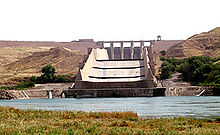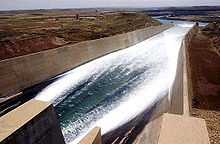- Mosul Dam
-
Mosul Dam 
Spillway of the Mosul DamLocation 45 mi north of Mosul, Ninawa Governorate, Iraq Coordinates 36°37′49″N 42°49′23″E / 36.63028°N 42.82306°ECoordinates: 36°37′49″N 42°49′23″E / 36.63028°N 42.82306°E Construction began 1980 Opening date 1986 Construction cost US$1,500,000,000 Dam and spillways Height 135 m (443 ft) Length 3.3 km (2.1 mi) Impounds Tigris River Reservoir Capacity 11 km3 (2.6 cu mi) Power station Turbines 4 Installed capacity 1060 MW Mosul Dam (Arabic,سد الموصل) or Chambarakat Dam, formerly known as Saddam Dam (Arabic,سد صدام), is the largest dam in Iraq. It is located on the Tigris River in the western governorate of Ninawa, upstream of the city of Mosul. The hydroelectric dam holds, at full capacity, about 11 cubic kilometres (2.6 cu mi) of water and provides electricity to the 1.7 million residents of Mosul. The dam has four 200-MW turbines but is believed to be producing around 320 MW. A pumped-storage hydroelectricity power plant with a capacity of 200 MW and a river regulating dam with a hydro power plant of 60 MW capacity belong to the Mosul Dam scheme. It is ranked as the fourth largest dam in the Middle East, measured by reserve capacity, capturing snowmelt from Turkey, some 70 miles (110 km) north.[1]
Contents
Construction
In order to bolster Saddam Hussein's regime during the Iran-Iraq War and promote Saddam's Arabization efforts in Northern Iraq, the construction of the Mosul Dam was important. Construction on the Mosul Dam began in 1980 by a German-Italian consortium that was led by Hochtief Aktiengesellschaft. Because the dam was constructed on a foundation of soluble gypsum, the engineers installed a grouting gallery that would allow continuous grouting of the dam's foundation in order to promote stability. Construction was complete in 1984 and in the Spring of 1985, the Mosul Dam began to inundate the Tigris River, filling the reservoir which submerged many archaeological sites in the region. Due to significant structural stability issues associated with the Mosul Dam, grouting and additional construction and repairs are constant. In 2007, the U.S. Army Corps of Engineers developed and executed a US$27 million plan to help continue maintenance and repairs on the dam in the short-term.[2][3]
Concerns about potential collapse
The earthen embankment dam is located on top of gypsum, a soft mineral which dissolves in contact with water. Continuous maintenance is required to plug, or "grout" new leaks with a liquefied slurry of cement and other additives.[4] More than 50,000 tonnes (49,000 long tons; 55,000 short tons) material have been injected into the dam since leaks began forming shortly after the reservoir was filled in 1986, and 24 machines currently continuously pump grout into the dam base. A September 2006 report by the United States Army Corps of Engineers noted, "In terms of internal erosion potential of the foundation, Mosul Dam is the most dangerous dam in the world." The report further outlined a worst case scenario, in which a sudden collapse of the dam would flood Mosul under 65 feet (20 m) of water and Baghdad, a city of 7 million, to 15 feet (5 m), with an estimated death toll of 500,000.[5] A report on 30 October 2007 by the US Special Inspector General for Iraq Reconstruction (SIGIR) said that the dam's foundations could give way at any moment.[6]
In 2004, dam manager Abdulkhalik Thanoon Ayoub ordered the dam's water level, which can reach 330 feet (101 m) above sea level, to have a maximum of 319 feet (97 m), thus reducing the pressure on the structure. Nevertheless, Iraqi officials maintain that the U.S. government is overstating the risk. The Army Corps of Engineers has proposed that the Badush Dam under construction downstream be expanded to obstruct the large wave which would result if the Mosul Dam collapsed. This has been resisted by Iraqi officials, who note that the current plan for the Badush Dam is US$300 million to provide hydroelectric power and help irrigation while the proposed expansion would cost $10 billion.[5]
Demolition concerns during the 2003 invasion
In early April 2003, following the invasion of Iraq by a U.S.-led coalition, military intelligence had developed several scenarios, including one in which Iraqi forces had wired the dam for detonation. This would, like a dam collapse, release the 110-metre (360 ft) high waterline of the lake reservoir, to reach Mosul in about two hours. Subsequent investigation found nearly 500 dam workers to still be at work nearly a month after pay had stopped being distributed, with security being provided by militia under the Patriotic Union of Kurdistan.[1]
Richard A. Muller, a physician and JASON Defense Advisory Group consultant on U.S. national security wrote:
“ His troops arrived at the huge Mosul dam to blow it up – but our military (with decisive help from local Iraqis) prevented them from doing so. ” See also
- Haditha Dam, second largest dam in Iraq
- Samarra Dam, next largest dam downstream from the Mosul Dam
Notes and references
- ^ a b "Iraqi Dam Has Experts On Edge Until Inspection Eases Fears" by Andrew G. Wright, Engineering News-Record, 5 May 2003
- ^ http://www.danielpipes.org/5107/saddams-damn-dam-ie-the-mosul-dam Saddam's Damn Dam
- ^ http://www.nce.co.uk/worries-grow-over-mosul-dam/304195.article Worries grow over Mosul Dam
- ^ "Mosul Dam Repairs Benefit Tigris Basins", defendamerica.mil, September 2005
- ^ a b "Iraqi Dam Seen In Danger of Deadly Collapse" by Amit R. Paley, The Washington Post, October 30, 2007
- ^ "Iraq dismisses Mosul Dam warnings" BBC news article BBC, October 31, 2007
- ^ Technology Review Online (MIT)
[The expected collapse of a large dam : Saddam dam in Irak; Michel Mesny . La Houille Blanche 4 (2004) 92-96 DOI: 10.1051/lhb:200404014[1]]
Categories:- Dams in Iraq
- Buildings and structures completed in 1984
- Hydroelectric power stations in Iraq
- Lakes of Iraq
Wikimedia Foundation. 2010.


